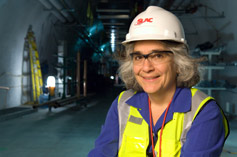
Handy Links
SLAC News Center
SLAC Today
- Subscribe
- Archives: Feb 2006-May 20, 2011
- Archives: May 23, 2011 and later
- Submit Feedback or Story Ideas
- About SLAC Today
SLAC News
Lab News
- Interactions
- Lightsources.org
- ILC NewsLine
- Int'l Science Grid This Week
- Fermilab Today
- Berkeley Lab News
- @brookhaven TODAY
- DOE Pulse
- CERN Courier
- DESY inForm
- US / LHC
SLAC Links
- Emergency
- Safety
- Policy Repository
- Site Entry Form

- Site Maps
- M & O Review
- Computing Status & Calendar
- SLAC Colloquium
- SLACspeak
- SLACspace
- SLAC Logo
- Café Menu
- Flea Market
- Web E-mail
- Marguerite Shuttle
- Discount Commuter Passes
-
Award Reporting Form
- SPIRES
- SciDoc
- Activity Groups
- Library
Stanford
Around the Bay
From the Director: The Future of Photon Science at SLAC National Accelerator Lab
Last week I had the honor of giving the keynote address at the Linac Coherent Light Source–Stanford Synchrotron Radiation Lightsource joint annual users' meeting on the future of photon science. Since my background is in particle physics and particle astrophysics, I was a bit nervous to presume to talk to the user community about their field of expertise. However it was fun to give a talk where I could paint a picture of the future of photon science at SLAC National Accelerator Lab, motivated by the scientific goals of the field.
The future of photon science at SLAC is playing out on two very different timelines. For the postdocs and graduate students in the audience, the future is the next 3 years. And as lab director, I also have to be concerned about the future a decade from now. We have opportunities now because visionary individuals had great ideas a decade or more ago. So I also talked about the long-term future of photon science at SLAC and our strategy to deliver both world-leading capabilities to the photon science user community and innovative mission-relevant scientific discoveries for the decades to come.
The near-term future is very exciting. SPEAR3 will reach 500mA operation and new and upgraded beamlines will come into operation, adding significant new capabilities. The LCLS project will welcome its first users in 2009. The response to the first call for proposals for LCLS beam time was excellent, with 28 proposals involving 219 scientists and requests for running time that saturate the available beam time by more than a factor of two.
To talk about the longer-term photon science future at SLAC, I had to start with the scientific goals. Many of the grand challenges in the field of photon science, which can be linked directly with challenges that face our society in the areas like energy production, improved health and environmental and climate control, are focused on increasing our understanding of and ultimately controlling matter at the level of atoms, electrons and spins. The future of photon science will be defined by the tools that allow us to observe and manipulate the ultrafast timescales of electron motion, the spatial scale of atoms and the energy scale of the weak interactions that hold electrons in correlated motion with near neighbors. To fully address this science will require light sources with better spatial, temporal and energy resolution that we can currently achieve, but the sources that will deliver breakthrough progress in these areas are within our reach.
I told the user community about the potential upgrades to LCLS and a possible PEP-X program in the decade to come. I also told them how SLAC and Lawrence Berkeley National Laboratory are committed to working together to provide optimal suite of capabilities to the national light source community here on the west coast over the next decade, in a collaborative rather than competitive fashion. LBNL has potential upgrades to fully utilize their soft X-ray storage ring, the Advanced Light Source, and they have a concept design for a revolutionary soft X-ray free electron laser. Which opportunities are realized and when is not our call. But SLAC and LBNL are firmly committed to offering best suite of technical solutions possible to provide access to the most exciting science for our own research and for our users.
My final message to the users was to emphasize that even as an outsider, I am excited by the tremendous scientific opportunities in their field as the free electron laser technology opens a new frontier of basic research along with the advances in storage ring technology. In addition, it is inspiring to think that the basic research into the structure and dynamics of materials that we participate in over the next decade has the real opportunity of delivering transformational advances that will contribute to solving some of society's greatest challenges.
—Persis Drell
SLAC Today, October 24, 2008
